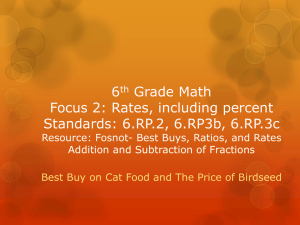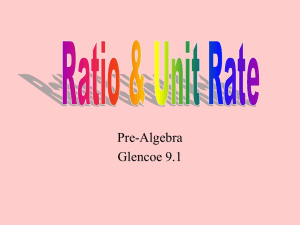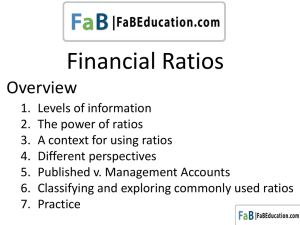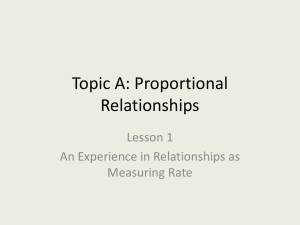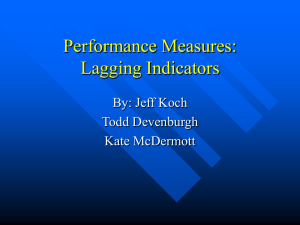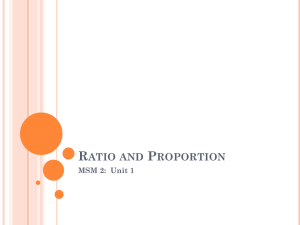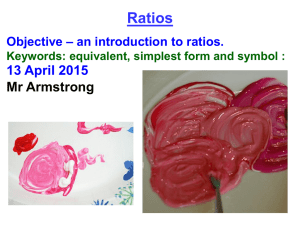Functions
advertisement
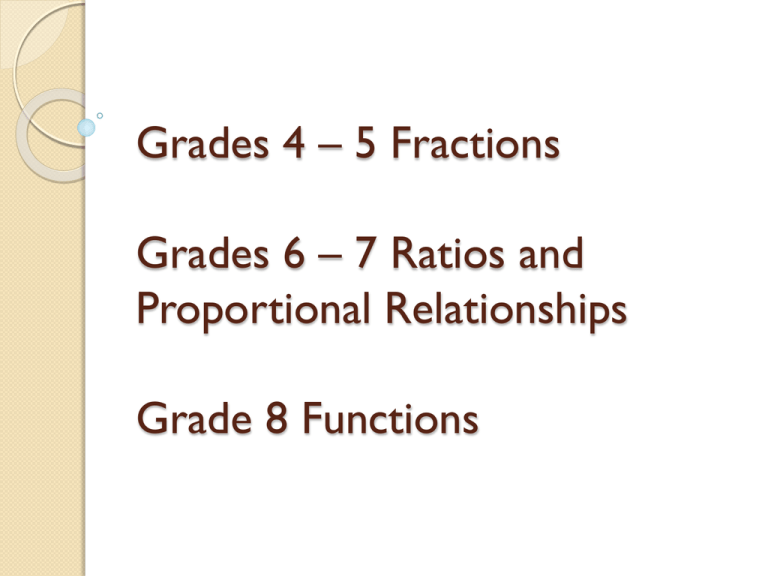
Grades 4 – 5 Fractions Grades 6 – 7 Ratios and Proportional Relationships Grade 8 Functions Progressions for the Common Core State Standards in Mathematics (draft) Ratio Proportional Progression 6 – 7 ©The Common Core Standards Writing Team 26 December 2011 Examples of Topic Progression Fractions Ratios Proportions Rate of Change Geometry - Similar figures, trigonometric ratios Science - Rate of change, average rate of change in Calculus, slope, speed, acceleration, density, quickness of technology Everyday - cooking, tips, tax, miles per gallon, discounts Statistics – demographics, economics, birth rate, body mass index, rain fall, medicine dosing Developing Essential Understanding of Ratios, Proportions & Proportional Reasoning Grades 6 – 8 National Council of Teachers of Mathematics Important Transitions - Ratios • Reasoning from one quantity to two • Moving from additive comparisons to multiplicative comparisons • Progressing from ratios as composed units to having a multiplicative relationship • Moving from iterating with composed units to creating infinitely many equivalent ratios through multiplication (rate) Rates Previous definition of rate: a comparison of two quantities of different units Alternate definition of rate: a set of infinitely equivalent ratios or a ratio in which one of the quantities is time Reasoning From One Quantity to Two Orange concentrate example: Sixth graders were shown a large and a small glass of orange juice filled by the same carton and asked if they thought both glasses would taste equally orangey or if one was more orangey than the other. Reasoning with Two Quantities Ramp example (p. 25): In order to use a ratio you have to isolate the attribute being measured. Ex. A ramp is composed of base length and height, but the attribute being measured is steepness of the incline. Reasoning with Two Quantities Ramp example (p. 25): Effects of changing one quantity. Ex. What happens to the steepness: base length is increased…decreased height is increased…decreased Moving from Additive to Multiplicative Comparisons When students focus on only one quantity they wrongly interpret ratios using additive comparisons. e.g. When asked to compare lengths they assume the question refers to “how much more” or “how much less” rather than “how many times bigger” or “What part is one compared to the other” Moving from Additive to Multiplicative Comparisons Use tables and repeated reasoning 1 2 3 4 5 3 6 9 12 15 Moving from Additive to Multiplicative Comparisons Use of double number lines and repeated reasoning m 0 5 10 15 sec 0 2 4 6 Ratios as Composed Units (iterating and partitioning) Composed units refers to the joining of two quantities to create a new unit. Consider mixing juices. 3 apple and 2 grape Here the composed unit refers to one batch. So now you can say let us iterate (multiply) or partition (divide) Ratios as a Fixed Number of Parts Consider mixing juices. 3 apple and 2 grape Out of 5 parts, 3 are apple, 2 are grape. This leads us to one is 3/2 of the other and one is 2/3 of the other Which leads us to y = cx where c is the constant of proportionality (rate of change/slope) Geometric Version Consider two similar triangles. 6 3 4 8 Ratios Having a Multiplicative Relationship (infinitely many equivalent ratios) Consider the length of Worm A is 6 in and the length of Worm B is 4 in A:B = 6:4 = 1.5:1 A is 1.5 times as big as B B:A = 4:6 = 2:3 = 1:1.5 A is 1.5 times as big as B Ratios and Fractions – do not have identical meaning Ratios are often used to make “part-part” comparisons while fractions are “partwhole” Ratios can involve more than two terms while fractions do not Ex. Ratio of types of milk in a store Ratios and Fractions – fractions reinterpreted Fractions can be reinterpreted as a point on a number line or an operator such as a scale factor Ex. Ratio of 2:5 as two-fifths of something Fractions as quotients can be reinterpreted as sharing Ex. Ratio of 2:5 as sharing two ounces among five minutes Recognize and Describe Ratios “for each” “for every” “per” “Two pounds for a dollar” needs more explaining. Is it every two pounds costs me a dollar or are we talking about a discount for every two pounds? Recognize and Describe Proportions If a factory produces 5 cans of dog food for every 3 cans of cat food, then when the company produces 600 cans of dog food, how many cans of cat food will it produce? If a factory produces 5 cans of dog food for every 3 cans of cat food, then how many cans of cat food will the company produce when it produces 600 cans of dog food? Recognize and Describe Multistep Problems After a 20% discount, the price of a SuperSick skateboard is $140. What was the price before the discount? A SuperSick skateboard costs $140 now, but its price will go up by 20%. What will the new price be after the increase? The solutions are different because the 20% refers to different wholes. Important Understandings Proportions • A proportion is a relationship of equality between two ratios - Equivalent ratios by iterating or partitioning composed units - If one quantity of a ratio is multiplied or divided, the same must happen to the other quantity to maintain the proportional relationship -The two types of ratios (composed units and multiplicative comparison) are related A Proportion is a Relationship of Equality Between two Ratios • Understand what the equal sign in a proportion means Ex. A clown walks 10 cm in 4 sec. A frog walks 20 cm in 8 sec. In the proportion 10/4 = 20/8 the equal sign means that the two speeds are the same. So the constant rate of change is the same or in other words both share the same unit rate Equivalent Ratios by Iterating or Partitioning Composed Units • Understanding begins with iterating with the composed unit by doubling, tripling, etc. • Next comes partitioning the composed unit by simplifying or finding the unit rate Maintaining the Proportional Relationship •Iterating as multiplication or repeated groups of both parts of the ratio • Partitioning as division or the repeated sharing of both parts of the ratio Composed Units and Multiplicative Comparison are Related • Use composed units to find both unit rates • Interpret the unit rates as the multiplicative comparisons • Use the multiplicative comparisons to represent the relationship in an equation Example: Orange Juice 3 concentrates 4 waters 1. 2. 3. Not as a ratio: Purely counting 3, counting 4 and putting them in fractional form As a ratio: Forming a composed unit of 3:4, iterating 6:8, and understanding that it tastes equally orangey As a rate: The student can use 1:4/3 to find any quantity of orange juice with equivalent strength Ratios, Rates, Proportions and Graphing Grade 6 – Use a table of equivalent ratios to plot the pairs of values on the coordinate plane Grade 7 – Use a graph to decide if two quantities are proportional (linear through the origin). Represent proportional relationships in the equation y = mx. Explain that the upoint (1, r) represents the unit rate and (0, 0) represents the starting point. Functions and Graphing Grade 8 – Interpret the equation y = mx + b as a linear function where m is the rate of change and b is the starting point. Understand that when b is nonzero the function is not proportional. Use slope to determine greater or lesser rates of change. Example of a Function Developing the Various Parts of a Function through Activities Functions 8.F 1 Understand that a function is a rule that assigns to each input exactly one output. The graph of a function is the set of ordered pairs consisting of an input and the corresponding output. Algebraic Ups and Downs In ratios we discover the relationship between the two or more given quantities In functions we discuss the relationship between x and y y is a function of x (y depends on what happens with x) Inquiry Lab – Relations and Functions Understanding the specific relationship that defines a function Compare different typical explanations Graphing Linear Equations Practice input/output Discover the equation y = mx + b Discuss how changing m or changing b effects the graphic representation and the verbal representation Zap It 1 Keep practicing, but in a different way Extend the Matching Game In 7th grade we used a game where each student had a different representation of a proportion (verbal, graphical, table, etc.). Extension: Have proportional, nonproportional and non-linear examples Applicable Problem Working your way back to the unit price Number of Pencils Rule Total Cost of the Pencils 3 ? $0.75 4 ? $1.00 5 ? $1.25 x y Write the rule as an equation using x and y Functions 8.F 2 Compare properties of two functions each represented in a different way (algebraically, graphically, numerically in tables or by verbal descriptions). For example, given a linear function represented by a table of values and a linear function represented by an algebraic expression, determine which function has the greater rate of change. Pledge Plans Real world context to help understand what changing the y-intercept really means Connections to Statistics Applicable Problem Determining the greater rate of change y = –2x y = 4x y=x y = –3x How does this relate to absolute value? Problem Solving Connections Bringing all the ideas of the unit together Real world context Functions 8.F 3 Interpret the equation y = mx + b as defining a linear function, whose graph is a straight line; give examples of functions that are not linear. For example, the function A = s2 giving the area of a square as a function of its side length is not linear because its graph contains the points (1, 1), (2, 4) and (3, 9) which are not on a straight line. Rising Towers Comparing geometric quantities to discover proportional versus nonproportional connections Applicable Problem Discern linear from non-linear situations Jose decided to hike up a mountain last Saturday. It took him the same amount of time to hike up the mountain as it did to hike back down. Label as linear or nonlinear: A graph comparing time x and elevation y A graph comparing time x and distance y Functions 8.F 4 Construct a function to model a linear relationship between two quantities. Determine the rate of change and initial value of the function from a description of a relationship or from two (x, y) values, including reading these from a table or from a graph. Interpret the rate of change and initial value of a linear function in terms of the situation it models, and in terms of its graph or a table of values. Zap it 2 and 3 Focuses on working backwards to find an initial starting point for non-proportional functions Applicable Problem The prices for entry into a science center are recorded below. Assuming the relationship is linear find the rate of change and initial value. Number of People (x) Total Cost (y) 2 $65 3 $80 4 $95 5 $110 Explain the meaning of the rate of change and initial value in the context of the question. Functions 8.F 5 Describe qualitatively the functional relationship between two quantities by analyzing a graph (e.g. where the function is increasing or decreasing, linear or nonlinear). Sketch a graph that exhibits the qualitative features of a function that has been described verbally. Books Upon Books Statistics connection Identify independent and dependent variables in a real world context Introduction to solving systems of linear equations Applicable Problem Explain the function in context The graph shows the number of gallons of water in a bathtub after filling it for a certain number of minutes. 20 Number of Gallons 18 16 14 12 10 8 6 4 2 0 0 1 2 3 4 5 6 Number of Minutes 7 8 9 10 Write an equation to represent the situation. Why is the slope increasing? What would the situation be if the slope were decreasing? The Activities Resources AIMS NCTM Navigating Series On Core Mathematics Glencoe Additional Resources Zeroing in on Number and Operations Grades 7-8 Anne Collins & Linda Dacey Additional Resources Illuminations: ◦ Function Matching ◦ Circle Tool Math Playground: ◦ Thinking Blocks ◦ Function Machine ◦ Equivalent Fractions Balanced Assessments: ◦ Bicycle Rides (functions) ◦ Pen Pals (measurement conversions)

